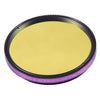Antlia
ANT-4.5SII-2EDGE
ANTLIA Narrowband 4.5nm SII EDGE Filter - 2"
£304.00
Liquid error (snippets/product-blocks line 75): divided by 0
Off
Unit price
/
Tax included.
Shipping calculated at checkout.
Generally In Stock, Please Confirm Before Ordering
ANTLIA Narrowband 4.5nm SII EDGE Filter - 2" (in 2" standard filter cell)
Just arrived! Even better value! High transmittance for working with both long focal ratios and fast optical systems (as fast as f/3 or maybe even f/2.8)!
The Antlia SII EDGE narrowband filter optimizes the FWHM (full width half maximum) to 4.5nm bandpass. The suppression of optical density (OD)5 on unwanted wavelengths and the excellent transmittance characteristics found in the Antlia 3nm Pro series has been incorporated into the 4.5nm EDGE narrowband filters. The result is that these filters deliver superior SNR(signal to noise ratio) and better contrast in your images.
The Antlia SII 4.5nm EGDE filters are designed to deliver high transmittance at the 671.6nm line that provides you with the maximum signal to reveal the faintest SII nebulae structures.
Conventional broader narrowband filters cause a heavy loss in transmission due to the strong Center Wavelength (CWL)-shift. We guarantee T>90% within 1nm range of the center bandwidth, which means that the SII 4.5nm EDGE narrowband filters can guarantee high transmittance for working with both long focal ratios and fast optical systems. Blue-shift data shows that Antlia 4.5nm EDGE filters can be used with nearly all systems as fast as f/3 with minimal loss in emission signal and meets the requirements of fast optics.
Application and Performance:
- High transmittance and narrow bandwidth to maximize contrast
- Steep spectral profile minimizes halos around bright stars
- A single substrate to eliminate internal reflections
- Narrowband Objects: SII Emission Nebulae, Planetary, Wolf-Rayet Nebulae and Supernova Remnants
- Use in light polluted areas and dark sites
- Extend imaging time when the moon is up
- Antlia narrowband EDGE filters can be used down to f/3 systems with minimal loss of signal
- All Antlia unmounted filters are edge blackened to eliminate internal reflections from stray light
- Superior optical reliability reduces post image processing
- This filter is only effective for deep sky objects that contain SII emissions
Technical Data:
- Basic Substrate: Optical, Single / Non-glued substrate
- Filter Thickness: 2mm+/-0.05mm for 1.25”, 2” mounted, Dia31mm and Dia36mm unmounted
- 3mm+/-0.05mm for Dia50mm unmounted
- FWHM (Full width at half maximum): 4.5nm
- CWL (Central Wavelength): 671.6nm
- Peak Transmission: >90%
- Blocking: > 5 OD(0.001% out of band blocking) @ 300-1000nm
- Surface Quality: S/D (scratch/dig)= 60/40 (Refer to MIL-O-13830)
- Transmitted Wavefront: Lambda/4 or better.
- Parallelism: less than 30 arcsec
Filter Cell (specifications for cell mounted filters only):
- 1.25” (M26*0.6),2” (M48*0.75)
- Ultra-thin filter cell to minimize vignetting by maximize possible clear aperture
- Black Anodized Finish
- Non-Fading Laser Engraving
Available Sizes:
- Mounted: 1.25” & 2”
- Unmounted:Dia 31mm,Dia 36mm
- Unmounted:Dia 50mm
Not Recommended:
- Solar Observing and imaging
- Visual observation
DO NOT LOOK AT THE SUN WITH ANTLIA FILTERS. Serious eye damage will result if you fail to observe the warning.
When Antlia design filters for astronomy imaging systems, they look at how they will work together with optical systems, carefully designing the out of band blocking rate, transmittance and band-pass parameters to achieve an optimum result. Each filter is individually tested and scanned by strict QC to ensure that the quality meets the high-performance parameters. The result is that Antlia is known for designing filters for astrophotography that achieve exceptional quality and performance parameters at affordable prices. We believe the price to performance ratio compares more favourably than similar premium filters in the market.
IMPORTANT NOTE:
No returns of Antlia narrowband filters are accepted due to halos appearing around bright stars.
Antlia made huge efforts to minimise halos around bright stars and achieved very good results by doing so, therefore you will most likely rarely if ever see halos, however this is a very complicated topic as halos can be caused by various elements in the optical train. There are thousands of possible scenarios and they simply cannot promise that there will be no case when some level of haloing will appear. The Antlia filters are extremely good and represent very good value, but only much more expensive filters (like Astrodon and Chroma) are likely to provide halo-free images. We also supply these filters, however in most cases Antlia filters would offer a near-to-perfect solution.


